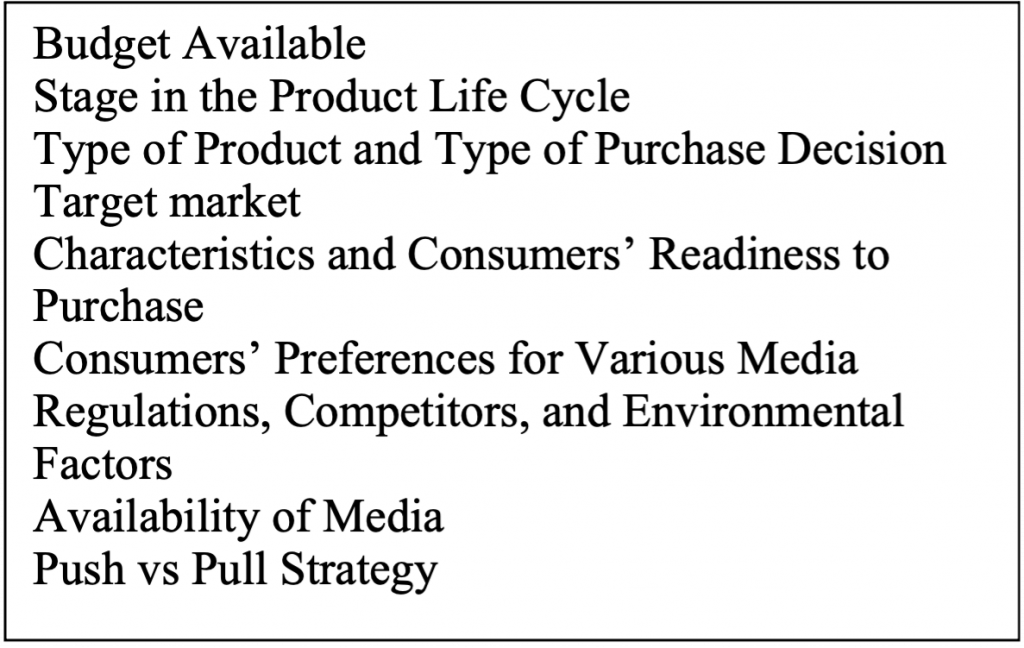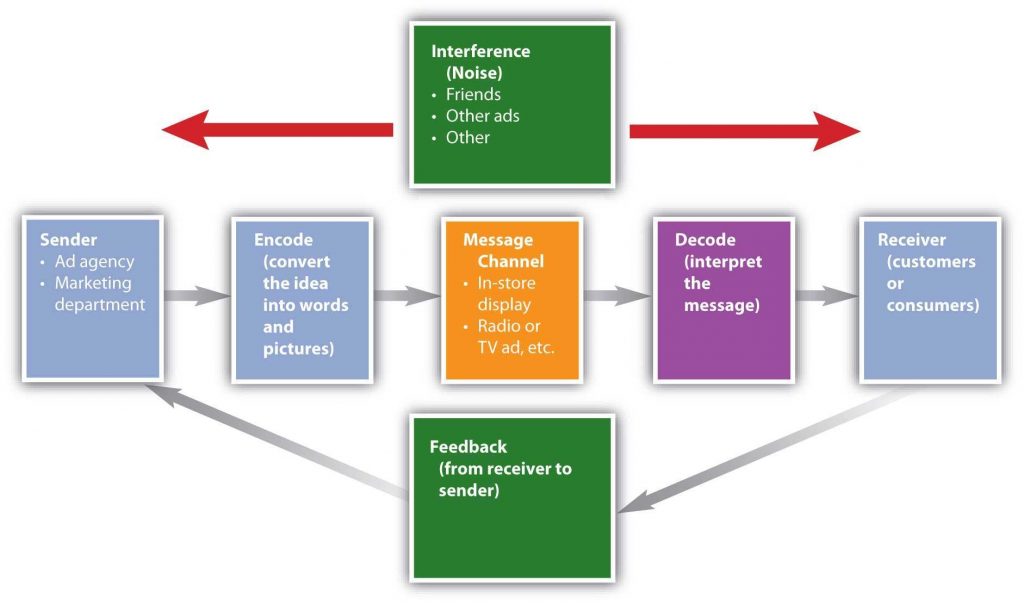Chapter 10 – Integrated Marketing Communications
10.3 Factors Influencing the Promotion Mix and Communication Process
LEARNING OBJECTIVES
- To understand the factors that influence the promotion mix
- To explore the communication process
Promotion is the plan of action that helps provide information to customers with the objective of motivating a purchase. Figure 10.2 identifies the factors that affect the choice of promotion mix elements.

Joanne McNeish, Ryerson University CC BY-NC 4.0
Budget Available
For many companies, the budget available to promote a product determines what elements of the promotion mix are utilized. The budget affects a promotion’s reach (number of people exposed to the message) and frequency (how often people are exposed). For example, many smaller companies may lack the money to create and run video commercials regularly or during high profile events such as the Super Bowl or the Olympics. As a result, they may not get the exposure they need to build to continue to grow their business. However, other forms of online marketing such as e-flyers gives them an opportunity to engage customers for less money.‡
Stage in the Product Life Cycle
The stage in the product life cycle also affects the type and amount of promotion used. Products in the introductory stages typically need a lot more promotional dollars to create awareness in the marketplace. Consumers and businesses cannot buy a product if they do not know about it. More communication is needed in the beginning of the product life cycle to build awareness and trial, however, it is critical to continue to speak to customers throughout the product lifecycle to maintain loyalty, to communicate changes, and to make it easier to introduce line extensions.
Type of Product and Type of Purchase Decision
Different products also require different types of promotion. Very technical products and very expensive products (high involvement) often need professional selling so customers understand how the product operates, its different features and benefits. By contrast, advertising is often relied upon to sell convenience goods and products purchased routinely (low involvement) since customers are familiar with the products and they spend relatively little time making purchase decisions.
Target Market Characteristics and Consumers’ Readiness to Purchase
In order to select the best methods to reach different target markets, companies need to know what types of media different targets use, how often they make purchases, where they make purchases, and what their readiness to purchase is, as well as characteristics such as age, gender, and lifestyle. Some people are early adopters and want to try new things as soon as they are available, and other groups wait until products have been on the market for a while so that the early technical problems have been solved.‡ Some consumers might not have the money to purchase different products, although they will need the product later. For example, are most people in their twenties interested and able to afford to buy a property versus renting?‡
Consumers’ Preferences for Various Media
The media preferences of the target audience is an important consideration in the selection of the promotion marketing mix. Media preferences are also linked to the type of product and service. Kantar produced a report that discusses the divide between which media consumers prefer and which companies prefer. Download a copy of the report here. In general, cinema, events, and print advertising are preferred by consumers, whereas marketers prefer TV and digital formats (Kantar, 2020). ‡
Regulations, Competitors, and Environmental Factors
Regulations can affect the type of promotion used. Canada has one of the most comprehensive self-regulated systems of codes and standards for responsible advertising called the Canadian Code of Advertising Standards and Broadcast Code for Advertising to Children (Ad Standards, 2019). The Code applies to advertising of products and services in any media. The criteria for acceptable advertising is that it is truthful, fair and accurate. ‡
Companies rarely operate in markets without competition. Marketers must think about whether they want to follow the lead of their competitors or to stand out by using different media. ‡
Environmental factors can have an impact. During COVID-19 pandemic, consumers were unwilling or unable to spend as they did before the pandemic. By March 2021, Canadian consumers had accumulated $184 billion in excess savings since the start of the pandemic a year earlier (Oxford Economics, 2021). This does not mean, however, that consumer spending was reduced across all industries. As consumers spent more time in their homes, home related expenses have seen a sharp rise. For example, major urban centers saw housing prices rise sharply, with people investing $62 billion dollars in housing and financial assets during the same time-frame. Those investments will have a ripple effect in the economy as people purchase products and services related to owning a home. ‡
Availability of Media
Companies must also plan their promotions based on availability of media. Top-rated television shows (based on the number of more viewers) and Super Bowl ad spots, for example, often sell out quickly and are much more expensive due to the limited number of spots available. Magazines tend to have a longer lead-time so companies must plan far in advance for some magazines. By contrast, because of the number of radio stations and the nature of the medium, companies can often place radio commercials on the same day they want them to be aired. ‡
Social media and online media may be immediate but because of the Facebook-Cambridge Analytical scandal in 2018, users are concerned about the way in which their meta data and posted content is being used. Uncontrollable events can affect a company’s promotions, too. If there is a snow or ice storm and your company is in the middle of a printed flyer promotion, delivery is likely to be interrupted. During a major crisis such as occurred during the COVID-19 pandemic, companies had to pivot to produce communication that acknowledged that consumers’ situations had changed. ‡
An example of advertising that Kruger Products (paper products such as toilet paper, paper towels) produced during the second of 2020 called “Unapologetically Human” can be found on YouTube. ‡
The Communication Process
The communication process describes how a person selects, and interprets information. For example, by selecting a specific book, blog, or even an elective class in school to read, a consumer is choosing the information to which they will be exposed. However, just because a consumer is exposed to some information does not mean they will pay attention to it, remember or correctly interpret what they saw or heard. ‡
The communication process (Figure 10.3) illustrates how messages are sent and received. The sender encodes, or translates, a message so that it is appropriate for the message channel. The receiver (customer or consumer) then decodes, or interprets, the message. For effective communication to occur, the receiver must interpret the message as the sender intended.

This image is from Principles of Marketing by University of Minnesota and is licensed under a Creative Commons Attribution-NonCommercial-ShareAlike 4.0 International License.
There can be interference between the sender and the receiver. Interference includes any distractions between receivers and senders during the transmission of a message. For example, think about when you are streaming a video and at the same time texting a friend. If an advertisement interrupts the video, will you pay any attention to the advertisement, continue texting, or even start doing something else? With all this interference, how likely is it that you will remember what brand was being advertised.‡
It can be difficult for an advertiser to get you to pay attention, much less remember the message. To increase retention, advertisers repeat the same message multiple times in different places. Not only must advertisers try to present consistent messages, they must also try to ensure that consumers interpret the message as they intended.
One of the reasons that advertisers adopted social media so quickly was that it provided the opportunity to deliver multiple meaningful messages For example, Facebook’s technology observes the posts users look at, like or comment on, which means Facebook can provide advertisers with the information to provide consumers with promotional messages that they will find meaningful. Facebook is able to deliver advertising messages that reflect the consumers’ interests, use the interests of people or groups as another way to understand consumers, as well as the places from which the signals from the users’ devices are sent. ‡

